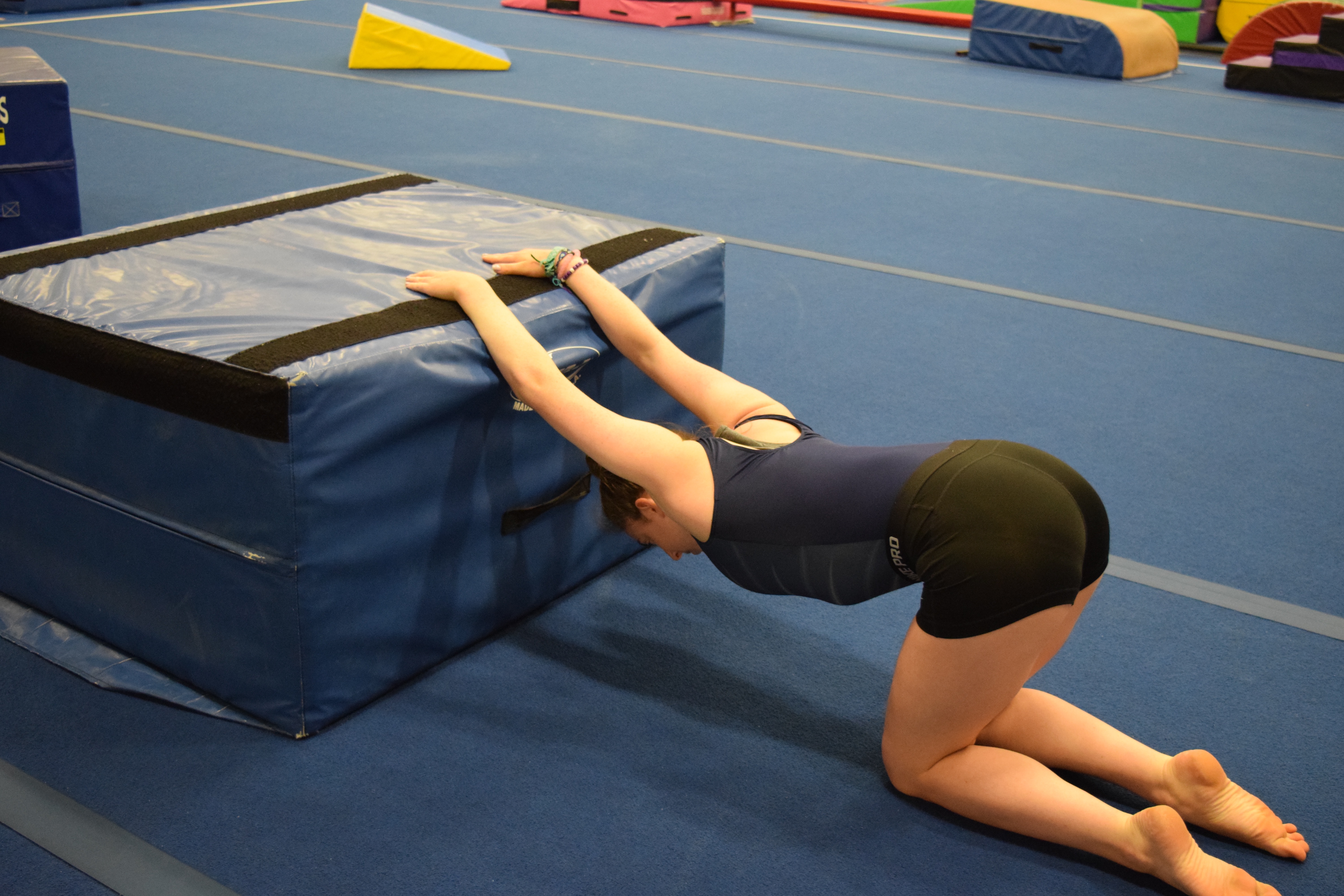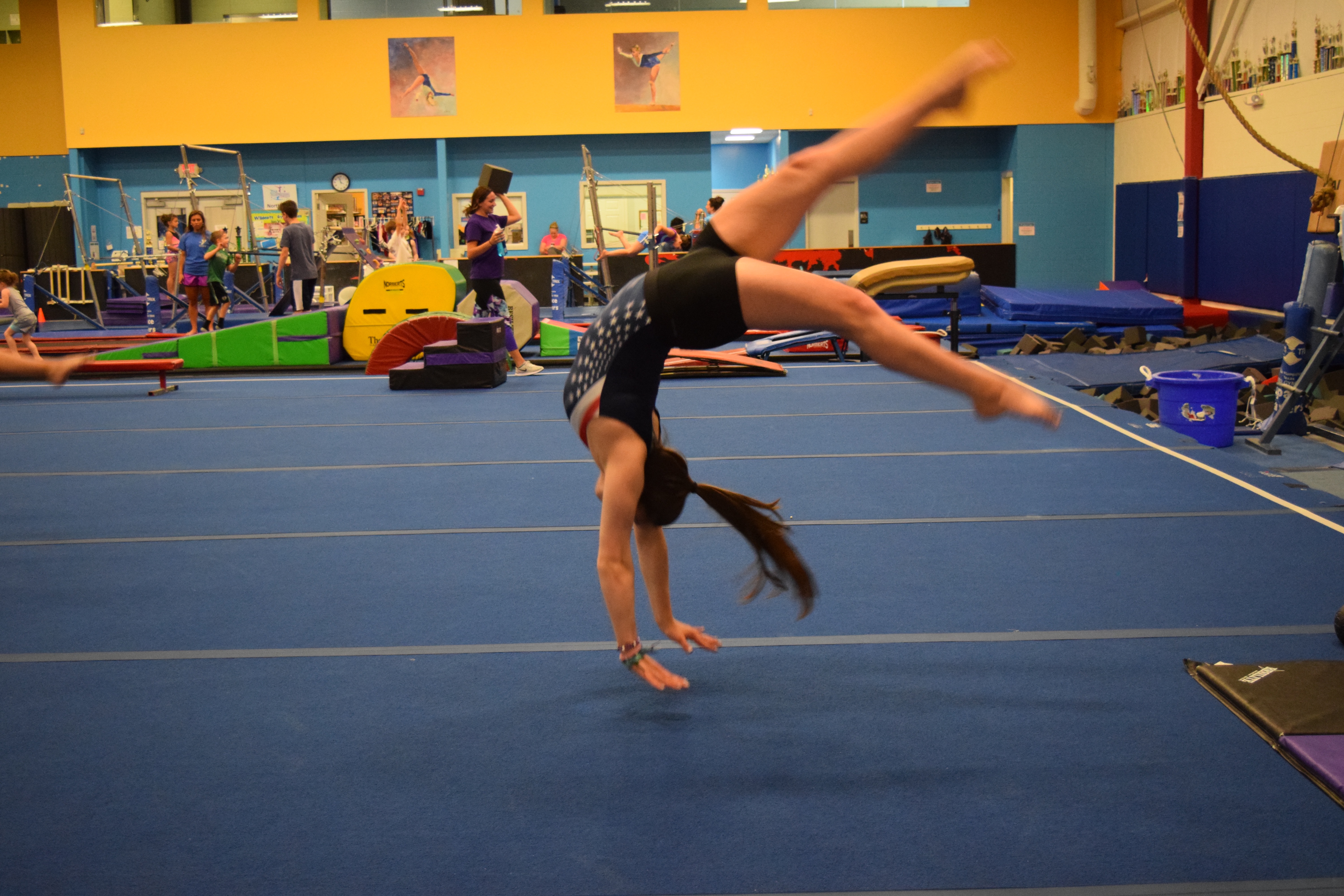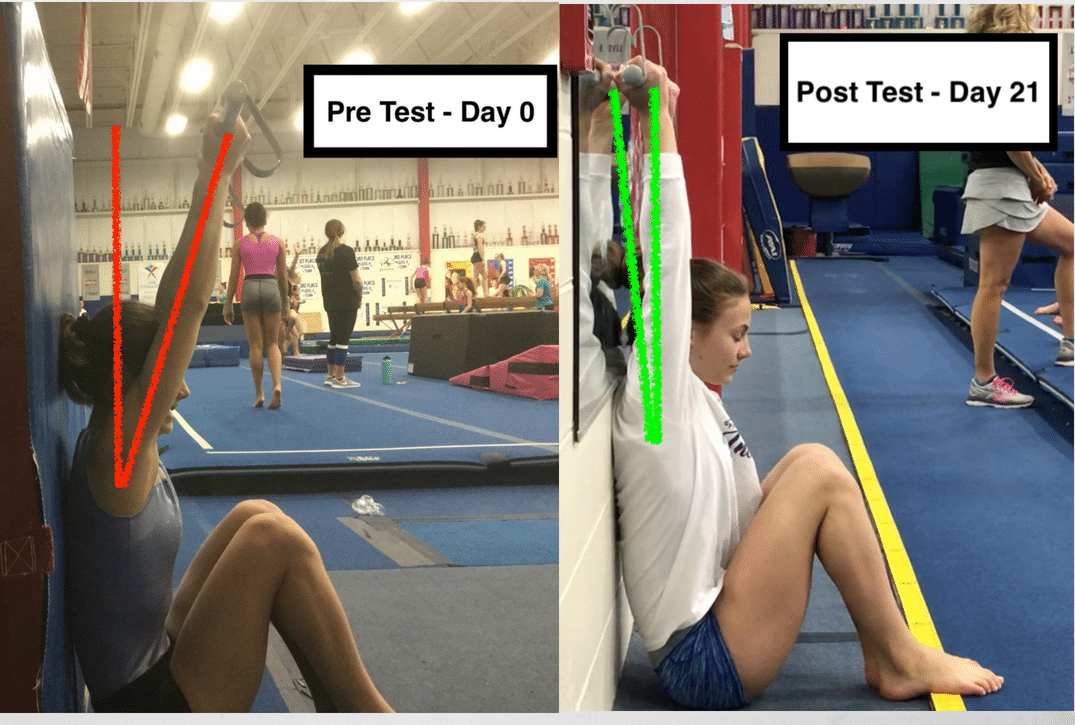Increase Split and Shoulder Flexibility with These Easy (Yet Not Commonly Used) Exercises
Hip flexibility for better splits or leaps, overhead shoulder flexibility for better handstands, and behind the back flexibility for better pommel or bar swings are very common issues many gymnasts or coaches face.
I’ve spent many years in gymnastics trying to troubleshoot these issues, and one of the most underused (yet most research supported) ways to increase muscle flexibility is through eccentric exercises.
The short definition for an eccentric exercise is one that requires a muscle to contract while it lengthens. I will explain more below, but loaded eccentric exercises are one of the most supported methods for truly increasing muscle length (although many other effects occur).
This is opposed to research suggesting many other common gymnastics flexibility methods such as static stretching, PNF or active flexibility, foam rolling, or vibration therapy, that are thought to increase range of motion through thedesensitizationn of the nervous system, rather than actually increasing muscle length (again, it’s a combination of effects). The best approach is a combination of these methods, but I find eccentrics are really overlooked in the gym outside of maybe some EZ slider drills. Here is some more info to use!
Table of Contents
How does this Apply to Splits, Handstands, and Pommel / Pbar Swings?
.
There are a few muscle groups that tend to really hang gymnasts up who struggle in basic positions of splits, handstands, and parallel bar swings. These areas are
Hip / Split Flexibility
- Hip Flexor Muscles (Iliopsoas) and Quad Muscles (Rectus Femoris more specifically) for Front Splits
- Inner Thigh Muscles (Various Adductors) for Straddle Splits
Overhead Handstand Flexibility / Behind the Back Pommel Flexibility
- Underarm Muscles (Latissimus Dorsi and Teres Major)
- Chest Muscles (Pectoralis Major and Min0r)
So connecting the dots here, one of the best ways that I have seen to increase the muscle flexibility specific to these motions is through the use of eccentrics. Over the last year, I have been giving out eccentric exercises to a lot of gymnasts, seeing very positive results. Following a proper assessment (and pending the gymnast is dedicated to doing these consistently through the week) I have seen some large improvements in both shoulder and split/leap range of motion.
Here are some of my go to exercises that I use every day.
Hip / Split Flexibility
- Eccentric Split Squats for Hip Flexor / Quad
- Eccentric Single Leg Deadlifts for Hamstring
- Eccentric EZ Slider Split Lowers using blocks for front and straddle splits (Eventually as a progression as the athlete must be mature and safe)
I really want to make sure readers go slow on adding these exercises in. As you can see from the videos, blocks are used to help the athlete lift themselves from the bottom position so they don’t get hurt. You will notice their splits are not too low, as I told them to have very square hips and due to us just starting this for the summer I did not want anyone to be at risk of injury. We use very light weights in a motion they can control with good form. The ability to do these exercises well is something that must be developed over months, not days.
Shoulder / Overhead Handstand Flexibility
- Eccentric Close Grip Chin Ups
- Eccentric Push Ups
- Eccentric EZ Tuck Slide Outs
Also an important note, a movement assessment needs to happen to make sure these areas are limited in their motion. Following the assessment, it’s worth noting these are not used by themselves. They are part of a larger flexibility circuit.
After a movement assessment, I give gymnasts some light foam rolling to the muscle group (30-60 seconds based on this research review), a pre-test measurement, some specific static or dynamic stretching (2×30 seconds based on this research review), 2 sets of 5-10 repetitions of eccentric exercises with a 5 second lower like shown above (based on research here, here, here, and here), and then a gymnastics specific movement to apply the new range of motion to.
Before I finish this and chat, if you are interested in learning literally everything I have thought about related to gymnastics flexibility, there is a full chapter about it in my new gymnastics e-book that is 100% free. The book has been blowing up, which I am beyond humbled and grateful for, with thousands of downloads across the world in the last few weeks.
WIthin it, I made sure to offer lots of specific stretching, soft tissue care, and strength work to increase hip flexibility. You can find the exact drills and circuits I recommend in my Gymnastics Pre-Hab guide here,
Download SHIFT's Free Gymnastics Pre-Hab Guide
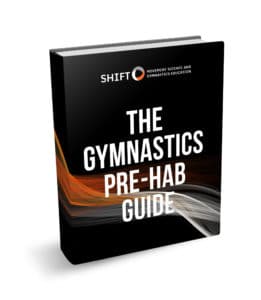
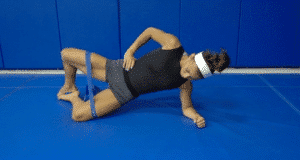
Daily soft tissue and activation exercises
Specific 2x/week Circuits for Male and Female Gymnasts
Descriptions, Exercise Videos, and Downloadable Checklists

Why Do Eccentrics Work To Increase Range of Motion?
.
Generally speaking, there are two main thought processes why eccentrics (and many other common techniques to increase flexibility) work. It appears that a combination of mechanical factors and neurological factors are the main theoretical reasons behind why regular stretching increases range of motion.
In terms of stretching induced neurological changes to the muscle tissue, the majority of the articles theorize that the main reasons behind this include
- • A reduction in the threshold of stretch reflexes within muscles• A reduction in the sensitivity of nerves that transmit signals of danger (nociceptors)
• A change in the brain related to perceived discomfort, and
• An increase in the levels of chemicals that are natural pain relievers, like enkephlin, within the body
All of these mechanisms may be occurring as people stretch consistently over a long period of time. The main articles that support this are by
- Weppler / Magnussun 2010 (find it here),
- Konrad 2014 (find it here), and
- Ben / Harvey 2010 (find it here)
With this being said, there are definitely studies that claim changes to the mechanical properties of the muscle, tendon, and junction between these structures change over time with stretching. This is especially true for eccentrics, as mentioned in the four research articles above. The majority of these articles theorize that the main reasons that stretching increases range of motion include
- a reduction in the amount of stiffness or compliance within muscles (viscoelasticity), although likely transient
- An increase in the length of contractile units within muscles (sarcomerogenesis)
- Increases in the water content, blood flow, and temperature within muscles acutely
The main articles that support this are a 2018 systematic review by
Want To Learn About All My Thoughts on Gymnastics Flexibility?
.
This concept is really the tip of the iceberg related to flexibility. The reality is that I have drastically changed my thought process in the last five years after reading a ton of research, working with a lot of gymnasts as a medical provider, and still seeing the ground level challenges as a coach.
As mentioned, In recently released a lot of new content for free related to hip flexibility. If you want to download the exact stretching and active flexibility drills I use, you can download my “10 Minute Gymnastics Flexibility Circuits” here,
Download My New Free
10 Minute Gymnastics Flexibility Circuits
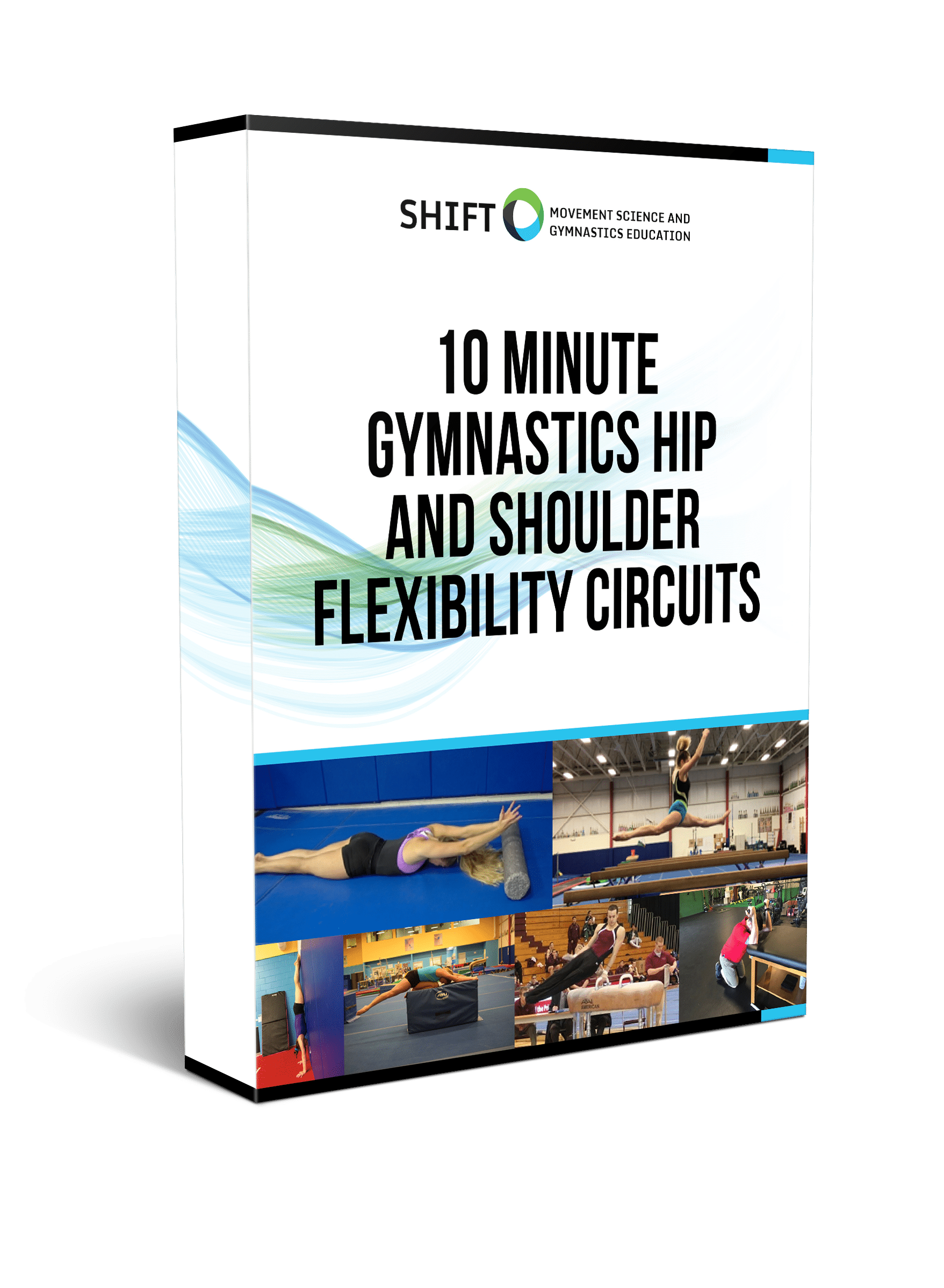
- 4 full hip and shoulder circuits in PDF
- Front splits, straddle splits, handstands and pommel horse/parallel bar flexibility
- Downloadable checklists to use at practice
- Exercise videos for every drill included
Hope it helps!


